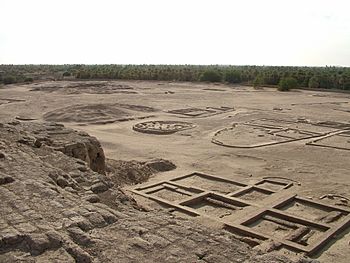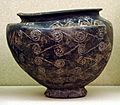Kingdom of Kerma facts for kids
Quick facts for kids
Kingdom of Kerma
|
|||||||
|---|---|---|---|---|---|---|---|
| c. 2500 BCE–c. 1500 BCE | |||||||
 |
|||||||
| Capital | Kerma | ||||||
| Government | Monarchy | ||||||
| hkꜣw | |||||||
| History | |||||||
|
• Established
|
c. 2500 BCE | ||||||
|
• Disestablished
|
c. 1500 BCE | ||||||
|
|||||||
The Kerma culture or Kerma kingdom was an ancient civilization. It was located in Kerma, Sudan, in a region called Nubia. This kingdom was very important from about 2500 BCE to 1500 BCE. It was one of many states along the Nile River during the time of the Middle Kingdom of Egypt.
In its later years, from about 1700 BCE to 1500 BCE, the Kerma kingdom grew very large. It took over the Sudanese kingdom of Sai. Kerma became a powerful empire, almost as strong as Egypt. But around 1500 BCE, the New Kingdom of Egypt took control of Kerma. Even so, people in Kerma kept fighting for their freedom for many years. Later, around 1100 BCE, a new kingdom called the Kingdom of Kush appeared. It might have come from Kerma. This new kingdom helped Nubia become independent from Egypt again.
Contents
What Was the Kerma Kingdom Like?
The main city of Kerma was the heart of the kingdom. It had a big town and a large cemetery. This cemetery had huge burial mounds called tumuli. The wealth found at this site shows how powerful the Kerma Kingdom was. This was especially true during the Second Intermediate Period, when Kerma even threatened Egypt's southern borders.
Where Did People Live in Kerma?
For a long time, we only knew about the Kerma civilization from its main city and cemeteries. But recently, experts have found many new sites south of Kerma. Many of these places were along old channels of the Nile River that are now dry. Finding these settlements tells us that many people lived in the Kerma Kingdom. It also helps us understand how the main city of Kerma fit into the larger kingdom. Ancient Egyptian records describe Kerma as a rich land with many farms and people.
How Did Kerma People Make a Living?
Most people in Kerma lived in small villages. They farmed crops in fields nearby. But some areas were also important for raising animals like goats, sheep, and cattle. Gold mining was another important industry. Some Kerma towns were centers for collecting farm products and managing trade.
Scientists have studied the skulls of thousands of cattle found in royal Kerma tombs. These cattle were sometimes brought from very far away. This suggests that people from rural areas gave cattle as a special gift or payment when a Kerma king died. This shows how important cattle were to the kings, much like in other parts of Africa later on.
Important Cities and Trade
Only the cities of Kerma and Sai Island seem to have had many people living in them. Maybe future discoveries will show us other important regional centers. In Kerma and Sai, there is a lot of evidence of rich leaders. These leaders managed trade, bringing in valuable goods from Central Africa. They also sent out goods from special administrative buildings. Clearly, Kerma was a very important place for trading luxury items between Central Africa and Egypt.
Images for kids
-
Head of a Male; found in Kerma. Granodiorite. Date: 1784–1668 BC. Middle Kingdom of Egypt, Twelfth Dynasty. It probably came from a sanctuary in southern Egypt; possibly taken to Kerma from Elephantine following a Nubian campaign in southern Egypt. Boston Museum of Fine Arts
-
Ancient Kerma bowl kept at the Museum of Fine Arts, Boston. "Bowl with Running-Spiral Decoration"








